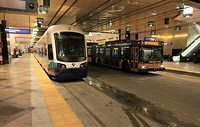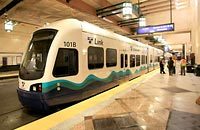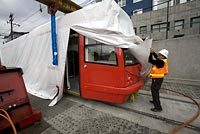Seattle gets a glimpse of its transit future

After a two-year closure and $94 million worth of construction to prepare for Sound Transit's future light-rail trains, the Downtown Seattle Transit Tunnel is ready to handle buses again, starting Monday.
The reopening is one of several projects coming soon to better move commuters throughout the region.
• In the South Lake Union area, a red streetcar arrived by truck Monday afternoon, the first of three to begin service in December.
• Two Sounder commuter trains will be added Monday between Seattle and Tacoma, and one will be added to Sounder's Everett-to-Seattle line.
• Link light-rail trains begin service from downtown to Seattle-Tacoma International Airport in the second half of 2009. Train tests inside the tunnel will start in October, on nights and weekends, Sound Transit spokesman Bruce Gray said.
• And, high-occupancy vehicle lanes are being added in Everett, Tacoma, on Highway 99 south of the airport and on the Interstate 90 floating bridges.
Two ceremonies are planned today to show off a light-rail car at Westlake Center and to unveil the new streetcar, which was built in the Czech Republic.
But long before those are ready to use, bus riders will again roll beneath downtown.
A tip for passengers: People in the renovated downtown tunnel should stay back from the curb so they won't be hit by bus mirrors. That's one of several hazards recently flagged by the union that represents King County Metro Transit bus drivers.
The tunnel floor has been lowered eight inches, so the boarding platforms will match the height of a new generation of low-floor buses and trains. Wheelchair users won't need a hoist, and other passengers won't need to step up.
But the lowering also brings the mirrors down to head levels, and the metal sides of the bus closer to the curb.
There are no railings on the boarding platforms, but they have a yellow stripe to encourage people to stand back. Metro added strobe lights to the mirrors, a public-address announcement and warning signs.
"We're confident this will help us operate safely," said Mike Lemeshko, supervisor of transit safety for Metro. "We don't want to bonk anyone."
The union also worries that as drivers approach the stations, they will leave too large a gap between the bus and platform, or come so close that buses scrape the curb.
Small bumps were installed in the pavement to help drivers guide their tires into the right place, and Lemeshko said the 15 mph speed limit at stations has been reduced to 10 mph.
Lance Norton, president of Amalgamated Transit Union Local 587, said: "Our union still has serious concerns regarding the safety of the public when leaving or entering the tunnel stations. The right side of the bus wheels must get onto the alignment and that's not an easy maneuver to make. If the rear wheels won't align, the gap could be significant."
Norton also said Metro should have added safety railings between platforms and the curb.
Metro operated the tunnel for 14 years and there was one fatality, at the Westlake station, when a man lost his balance and fell into the roadway. Lemeshko said a driver who sees someone too close to the edge can tap the horn or stop.
The union also points out that bicyclists will step down 14 inches when they load cycles onto a bus at the International District Station. Metro replies cyclists are generally athletic and unlikely to trip.
Brighter lighting, signs
Buses will run 14 hours a day in the tunnel, five days a week. Trains, when they begin in 2009, will run 20 hours a day, seven days a week. Metro hasn't decided whether it will extend the bus hours.
The tunnel's appearance has not changed much, but the lighting and signs are much brighter. One new feature is an overhead wire that will transmit power to the trains.
Meanwhile, Third Avenue, which became a bus-and-bike street at peak hours during the two-year tunnel closure, will remain that way.
More than 20 downtown surface routes will be shifted to Third Avenue, replacing 18 bus routes that will enter the tunnel.
The tunnel retrofit cost $94 million; $85 million came from Sound Transit and $9 million from Metro. That includes the cost of the stub tunnel, which will not only be the turnaround point for the trains but the kickoff for an eventual rail tunnel to Husky Stadium.
The project came in 3.4 percent over budget, said spokesman Gray. The agency says "multiple unanticipated challenges" arose — for instance, diagrams from the original project were inadequate, according to a Sound Transit report.
The tunnel was closed, in part, to fix a blunder made nearly 20 years ago. The old Metro Council decided to install rails in the tunnel, which first opened in 1990, so it wouldn't have to be closed years later, when light rail would presumably be added. But the rails weren't insulated adequately; stray electric current from trains could corrode nearby utility lines.
Sound Transit wound up closing the tunnel to, among other things, rip out the rails Metro spent $5 million putting in.
When the recent two-year project began, huge traffic jams were expected. But by most accounts, it was relatively painless.
Transit agencies paid for street and transit improvements to help offset the tunnel closure. Six months into the project, a Metro report found that the time it takes to travel by bus through downtown during rush hour had increased an average 2 ½ minutes.
Streetcar arrives
The new South Lake Union Streetcar line, owned by the city of Seattle and operated by Metro, begins in December. The first red car, under a white cover, was delivered Monday by a flatbed truck. Orange and purple cars will arrive later.
Testing begins in mid-October on the street, with a tentative service start Dec. 12, said Ethan Melone, the city's streetcar-project manager.
The 1.3-mile streetcar, from Westlake Center to the Fred Hutchinson Cancer Research Center, cost $50.5 million. About half is paid by a tax on nearby property owners, including Paul Allen's Vulcan. The remainder comes from city residents and federal grants.
Streetcars will be faster than pedestrians but slower than a bicycle. Some riders will use them as part of a commute to growing biotech industries, but the line will depend heavily upon tourism, shopping, lunchtime use and midday trips.
Seattle is considering possible streetcar extensions, while a Sound Transit streetcar from the International District station to Capitol Hill is part of a bigger regional ballot measure this fall.
Times reporter Eric Pryne contributed to this article. Susan Gilmore: 206-464-2054 or sgilmore@seattletimes.com



Key transit dates
Monday: The Downtown Seattle Transit Tunnel reopens, carrying buses 14 hours a day, five days a week.December: The South Lake Union Streetcar begins its 1.3-mile route from Westlake Center to the Fred Hutchinson Cancer Research Center.
Late 2009: Light-rail trains begin service from downtown Seattle to Seattle-Tacoma International Airport.
2016: Light-rail service is expected to reach Husky Stadium.
When the bus tunnel reopens
In the tunnel: The tunnel will be used by Metro routes 41, 71, 72, 73, 74 express, 101, 106, 150, 174, 194, 212, 217 (mornings only), 225, 229, 255, 256, 301 and Sound Transit Express 550.On Third Avenue: Bus routes assigned to Third Avenue when traveling through downtown Seattle include Metro routes 2 express, 5, 11, 16, 17, 21 express (mornings only) 23, 35, 54, 55, 56 express (mornings only), 66, 113, 116, 118, 119, 120, 121, 122, 123, 125, and 358.